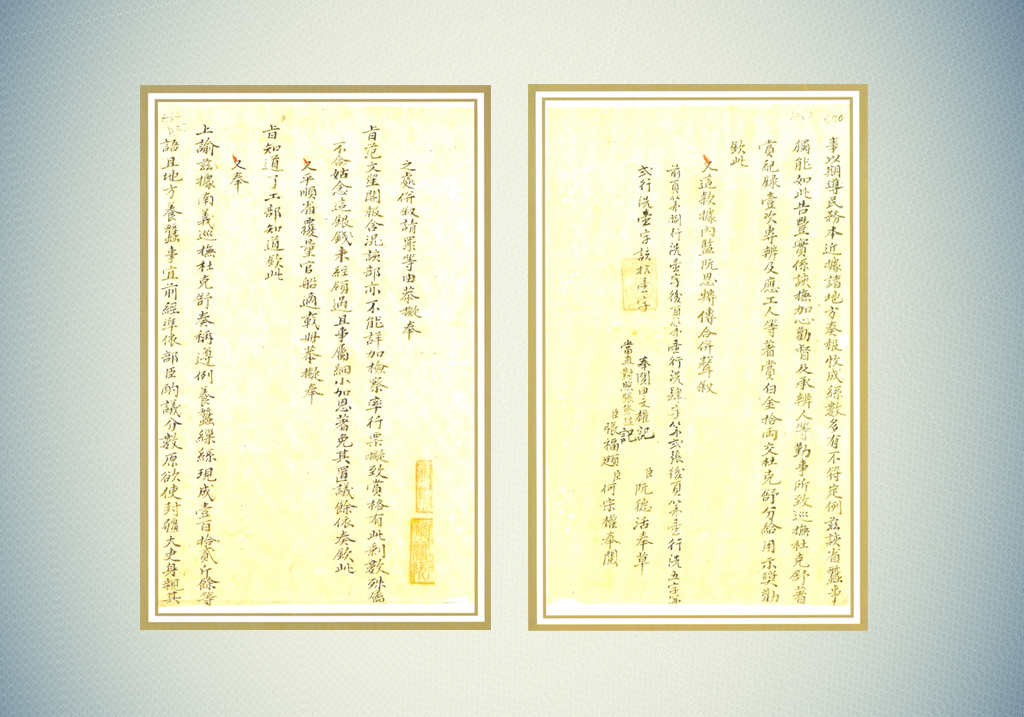(TITC) - Imperial records are documents approved in
red ink by kings. Nguyen Dynastyís Imperial records are administrative records created
during the transaction of state management activities of Nguyen Dynasty (1802 Ė
1945), the last feudal dynasty in Viet Nam, including records of grass-root and
central administrative organizations submitted to the kings for approval,
records created by the kings, diplomatic notes and literature works composed by
royal family.
The whole collection of Nguyen Dynastyís
Imperial records has 773 volumes, which is equivalent to about 85,000 documents
of 11 Nguyen Dynastyís kings (Gia Long, Minh Mang, Thieu Tri, Tu Duc, Kien
Phuc, Ham Nghi, Dong Khanh, Thanh Thai, Duy Tan, Khai Dinh and Bao Dai). Imperial
records of the Nguyen Dynasty are in various types of documents, including
royal proclamation, edicts, decrees, petition, reports, replies, comment
papersÖ which were created under strict regulations regarding their function
and authority of issuance.
Nguyen Dynastyís Imperial records are basically handwriting on do (poonah) paper, reflects all aspects
of social life, historical changes, domestic and foreign policies on politics,
economy, diplomatic relation, military, culture, social affairs, religion and
so on in Viet Nam in 19th century and early half of 20th century.
Outstanding values of Imperial records of Nguyen Dynasty
Authenticity
Events documented in Imperial records
had high authenticity because they were information used in practical
management of the society and were received and processed directly by the kings
under Nguyen Dynasty. Nguyen Dynasty defined strictly format of Imperial
records. Together with evidence remaining on records such as the kingsí
handwriting, sealsÖ, it made imperial records very difficult to fake.
Imperial records were used as a
historical source to compile books. Therefore, its authenticity can be double
checked by comparing its information with books officially compiled in Nguyen
dynasty, such as Dai Nam thuc luc chinh bien (Royal Annals of Dai Nam), Dai
Nam nhat thong chi (Dai Nam Comprehensive Encyclopedia), Dai Nam liet truyen (Dai Nam Biographies), Kham dinh Dai Nam hoi dien su le (Royal rules and regulations),
Quoc trieu chinh bien toat yeu (Brief
History of Nguyen Dynasty)Ö
World significance
Imperial records have comments written
directly by the Nguyen Dynastyís kings in red ink and in 4 types of
scripts, including Chinese, Nom
(Chinese-chino transcribed Vietnamese), French and Vietnamese. Imperial records were handwritten with a
brush and drafted by clerks who were examined and recruited for their
literature talents and beautiful handwriting. The system of scripts used in Imperial records reflects changes in
language used in Viet Nam from early
19th century to mid 20th century as well as changes in
social thought and the impact of cultural waves from colonizers entering to
colonized countries.
Imperial records also
reflect trade activities of Viet Nam with countries in the region and the world
such as Indonesia, Singapore, Philippines, Thailand, China, France, England,
Spain...
Rarity
Nguyen Dynastyís
Imperial records are the only
archival holding of a
feudal regime remained in Viet Nam and among very few documents in the world
that have autographs of the kings, who commented in details on all national
issues in the documents. They are the valuable original materials that
facilitate the researching and restoring the whole political, economic,
cultural and social system and people of a nation in a course of history. Going through a long time, seals on the
documents, autographs by the kings, the format of the document, the language, scripts, paper material, ink... have become precious antiques, provided lot of useful information about
different areas including administration studies, document studies, family
annals studies and seal studiesÖ
Integrity
With 773 volumes of
about 85,000 documents, Nguyen Dynastyís
Imperial records are a rather
complete and comprehensive collection of a feudal regime in Viet Nam that remains. Nguyen Dynastyís Imperial records are also
important documents to contribute to affirming Viet Namís sovereignty over 2
archipelagos of Hoang Sa (Paracel) and Truong Sa (Spratly). Among 85,000
documents, 19 ones record detailed information on Nguyen Dynasty assigned Hoang
Sa Naval Force to Hoang Sa and Truong Sa archipelagos to measure sea routes,
exploit sea products, plant the sovereignty landmarks... and also Nguyen
Dynastyís approval for rewarding and punishing in protection of these two archipelagos.
In particular, the Imperial records showed Viet Nam is a responsible sea country
for rescuing boats of other countries in danger in sea area of Hoang Sa and
Truong Sa archipelagos.
With unique and
outstanding values, on 14 May 2014, in the 2nd session of the 6th
general meeting of Memory of
the World Committee for Asia/Pacific (MOWCAP) at Guangzhou (China), Imperial records of Nguyen
Dynasty were recognized as documentary heritage in the Memory of the World Programme in the Asia/Pacific region.
Currently, the massive document
treasure is being preserved in National
Archives Centre I (18 Vu Pham Ham, Yen Hoa Ward, Cau Giay District, Ha
Noi).
Thu Giang






